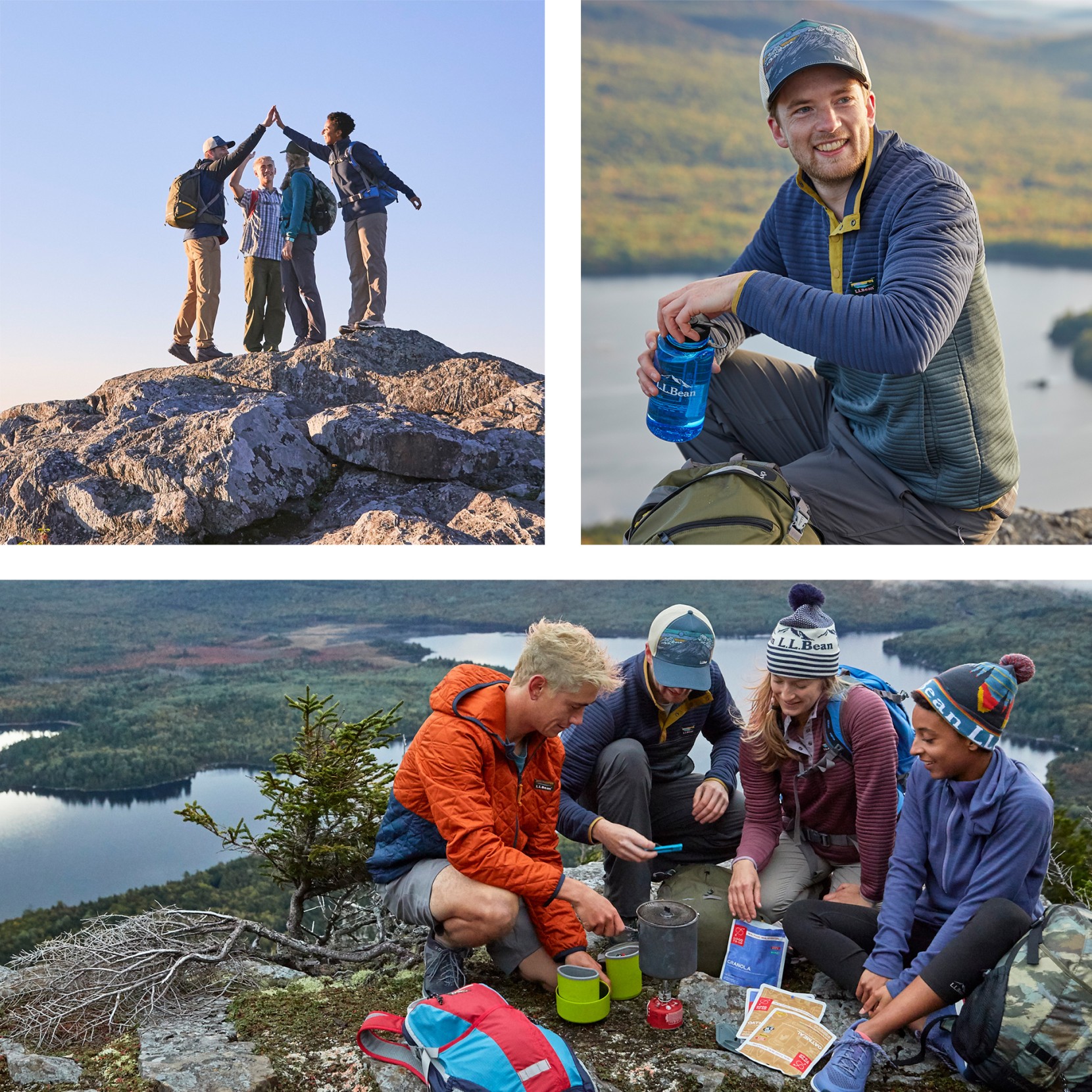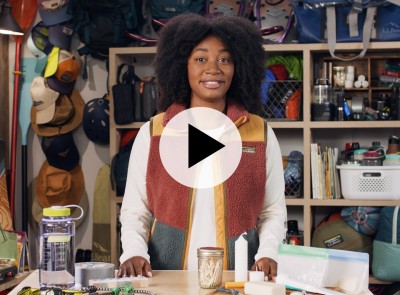(SPEECH)
[00:00:00.00] [MUSIC PLAYING]
(DESCRIPTION)
[00:00:00.07] Text, L.L.Bean, How to Prep for a Hike
[00:00:02.83] Three people in puffy jackets and hats sit next to back packs on a rock over looking a lake below with fills in the distance.
[00:00:04.38] Text, Kris, L.L.Bean ODP Instructor.
(SPEECH)
[00:00:04.87] Hello. My name is Kris and I'm with L.L.Bean’s Outdoor Discovery Programs. Today, we are going to be talking about how to prepare for a hiking trip.
[00:00:12.61] The first thing that you're going to want to do is start by making a plan. Once you've picked your location, do some research about the area. Find maps, guidebooks, and study those. When you're planning your route, it's important to be conservative with the amount of mileage that you think you're going to cover in a day.
[00:00:29.93] Another factor that you want to take into consideration is what the weather is going to be like when you're going for your hike. And that's going to help determine what you're going to put on your pack list.
(DESCRIPTION)
[00:00:38.34] Text, Day Hike. Kris stands in front of a table with items laid out and points to each item as he introduces them.
(SPEECH)
[00:00:39.91] If you're going for a day hike, the pack list isn't super extensive. Those things include wearing the appropriate clothing. So what I have on right now is some nice lightweight, synthetic clothing. I'm not wearing any cotton and that allows me if I get wet or anything, it allows it to dry easier, which just makes it more comfortable.
[00:01:01.30] Another thing that you'll want to pack is some additional clothing. If you go for a day hike and the weather's comfortable, you start off and it's sunny, and it's bright. But then, you end up being out on the trail and you're on the trail maybe longer than you had expected, or it cools off, or a pop-up rainstorm comes along. It's really handy to have an extra fleece and have a rain jacket stowed in your pack. You may not use them, but you might be very happy to have them if you do.
[00:01:28.78] Another thing that you're going to want to have is your backpack. A 20-liter backpack or so, somewhere in that size range, is appropriate. Trekking poles, should you choose to use those. And then, sun protection. So I like to have a hat, sunscreen, lip balm, and sunglasses.
[00:01:43.78] Another thing that's really helpful is having a whistle. You've got that in your pack somewhere readily accessible, that can be great. Should you have either an emergency or if you get lost, you can blow on a whistle a lot longer and a lot louder than you could ever yell.
[00:02:00.10] Having some bug spray is a great thing to also have packed. Having a map and a compass of the area that you're going to go for a hike. You'll want to pack some water and some snacks, granola bar or fruit. I also like to make sure I've always got some chocolate.
[00:02:14.89] I also like to make sure that I've got my cell phone. You may be going hiking someplace where you don't have great cell service. And so for that reason, I like to keep my cell phone turned off so that it's not wasting battery, searching for a signal. But if I have it turned off and I've got the battery charged, that way if there is something where I do need to try to call someone, I can turn my phone on and then start trying to find service.
[00:02:38.11] Any personal medications that you might need to have, like an EpiPen-- definitely want to make sure you pack those. And a first aid kit is important. Making sure you've got a camera to take in all the views that you're getting to experience on your hike is great. And lastly, I always bring a headlamp, just in case things don't go as planned. You might be really happy to have that headlamp if you've got to find yourself out of the woods after the sun goes down.
(DESCRIPTION)
[00:03:03.03] Text, Multi-Day Hike
(SPEECH)
[00:03:03.76] If you're looking to make your hiking trip be longer than just a day hike, then you're going to need to pack more things. You're still going to need the stuff that we talked about initially. You're going to need the sun protection, the whistle, cell phone, map and compass, bug spray, trekking poles, some extra layers. You're also going to need a little bit of a bigger backpack because, well, we have a little bit more stuff that we've got to bring along with us.
[00:03:28.69] The day pack, that can be around a 20-liter pack, just for going out for a few hours. If you're looking to do a trip that's one to two or three nights, that you'd want to have something in the 30 to 50-liter range. And if you're looking to do more of an expedition in the five to seven-night range, that you'd be looking to have a 50 to 70-liter backpack.
[00:03:51.82] You're going to want to have your cook stove and a plate, bowls, some utensils, a cup, and then what you prepare for a meal. There's an endless number of possibilities. You can get really creative by making your own prepackaged and prepare things in advance. Or you can take the easy route, which I often like to do, with these dehydrated meals. It'll also be important to make sure that you've got some fire starter, like waterproof matches.
[00:04:17.83] The other component that you're going to want to think about is what is your shelter going to look like. So I have here-- I've got my hiking, backpacking tent. And then, the other things that you're going to want to make sure you have is some sort of comfortable ground pad. This is the Hikelite pad, which is really nice, lightweight, and it packs up into a small space. So it doesn't take up a lot of room in your backpack, but it's also really comfortable.
[00:04:43.01] And then, the sleeping bag. That's going to change, depending on the time of year or what kind of weather you're going to be experiencing.
[00:04:50.45] So you'll also want to think about what you're bringing for extra clothing. You can't pack for every day of your trip a new set of clothes. So it's nice to have a set of clothes that you're hiking in and then a nice set of clothes that are going to be nice and dry in a dry bag that you can have to change into after your day of hiking. I also like to bring a pair of sandals. The sandals are nice so that at the end of the day, you can take those hiking boots off and give your feet a little bit of time to relax.
[00:05:19.85] Another piece that you're going to want to think about for your pack list is what you need for your personal hygiene. So toothbrush and toothpaste, camp soap, something that is environmentally friendly and something that you can wash if you do have a stream or a body of water nearby.
[00:05:37.24] And then, you're also going to want to know what your bathroom situation is like. Some backcountry sites do have privies. Still a good idea to bring the toilet paper. There's a lot of information and good content around Leave No Trace and how to visit backcountry and wilderness areas without leaving your mark of being there and leaving it nice and pristine for the next people who come through.
[00:05:59.80] The weather definitely can play into your plans and you have to prepare for that. I actually also like to print out a copy of the forecast the day right before I leave, just so I've got an idea as to what to expect then what's coming up on my trip. If there's a chance that you might have wet weather, it's also really nice-- a small little packable pack cover, something like that, that'll go over your whole pack, will help keep it dry. Or another option that you can do is take a large trash bag or contractor trash bag and put that inside your backpack. And then, put all of your contents in it and close that up.
[00:06:39.91] There's a number of ways that you can do this. Some people like to go really light and be very minimalistic. Certainly a great idea if you plan on covering a lot of miles or a long trip. But maybe you like to have a little bit more comfort and you don't mind carrying a little more weight and then you're going to have some more stuff than this.
[00:06:58.69] My recommendation is, make a list. Put everything on the list, even the obvious things, so that you don't forget something like a tent, which would seem obvious, but would be a big bummer if you didn't have it. And have fun with it. The planning, and the prepping, and putting the pack list together, for me, that's half of the fun of the whole adventure.
[00:07:16.99] And then, if you do want to learn how to get all of this into this, we do have a video for that on how to organize your backpack. So check that one out as well.
[00:07:27.88] [MUSIC PLAYING]
(DESCRIPTION)
[00:07:28.75] Text, L.L.Bean, Be an Outsider
[00:07:32.08] Photo of a hiking group walking up a rock overlooking an expansive vista with rolling hills in the distance while the sun sets.











